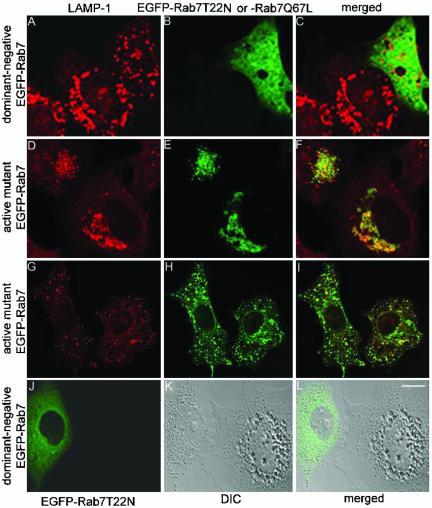Figure 10.
Essential role of Rab7 for VacA-induced clustering of late endocytic compartments and vacuolation. (A-F) HeLa cells were treated with 5 μg/ml acid-activated wild-type VacA for 20 h. Cells were then transiently transfected with either pEGFP-Rab7T22N (A-C) or pEGFP-Rab7Q67L (D-F) for 24 h. Cells were fixed, permeabilized, and stained with an anti-LAMP-1 antibody. In cells expressing the active mutant EGFP-Rab7Q67L or nontransfected cells, perinuclear aggregates of late endocytic compartments formed in response to VacA (A-F). In contrast, in cells expressing the dominant-negative mutant EGFP-Rab7T22N, late endocytic compartments remained localized throughout the cytoplasm without evidence of clustering after treatment with VacA (A-C). (G-I) HeLa cells were treated with 5 μg/ml acid-activated VacAΔ6-27 for 20 h. Cells were then transiently transfected with pEGFP-Rab7Q67L (encoding active mutant Rab7) for 24 h. Cells were fixed, permeabilized, and stained with an anti-LAMP-1 antibody. No clustering or redistribution of late endocytic compartments was detected. (J-L) Cells were treated with 5 μg/ml acid-activated wild-type VacA in the presence of 5 mM ammonium chloride for 18 h. Then, vacuolated cells were transfected with pEGFP-Rab7T22N (encoding dominant-negative mutant Rab7). Vacuolated cells reverted to a nonvacuolated appearance after expression of the dominant-negative Rab7. Bar, 10 μm.

